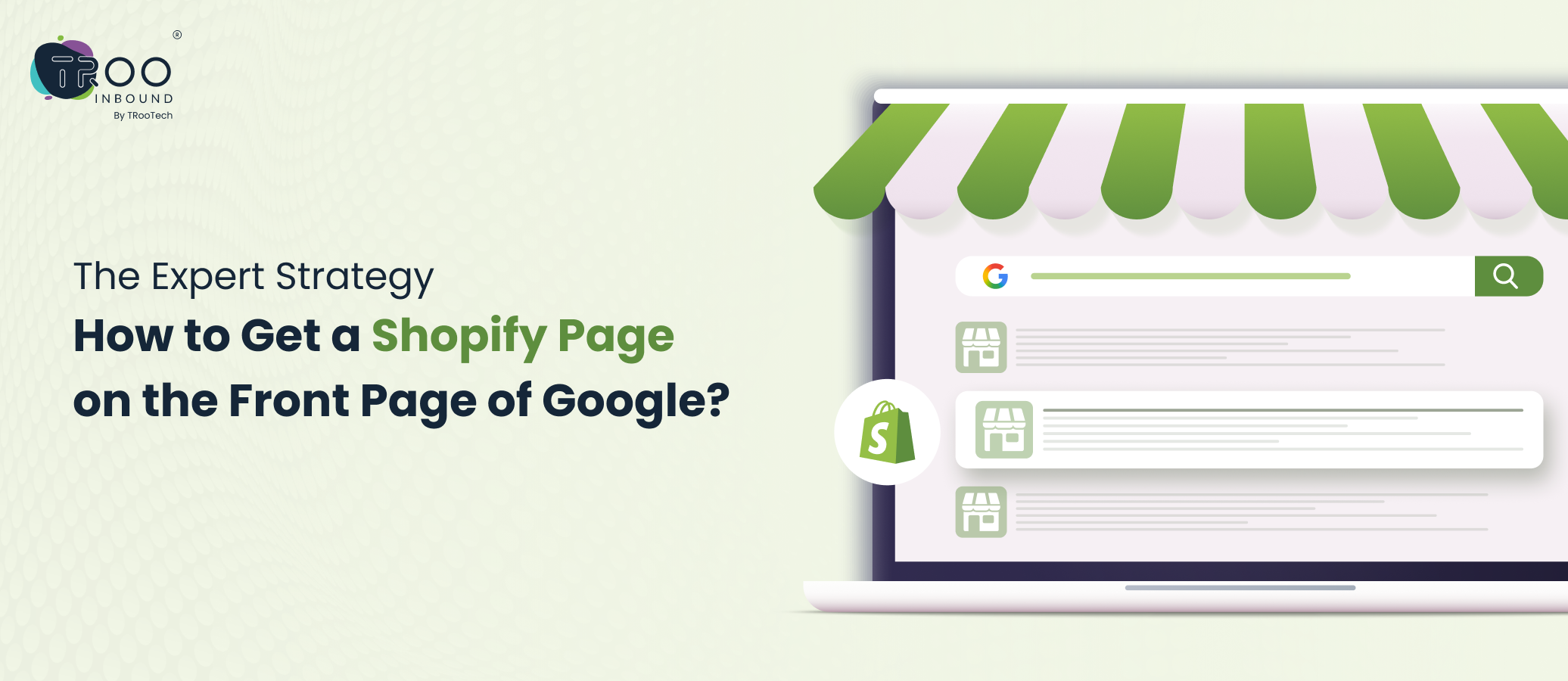Didn’t Discover!!
What You're Looking For?
Didn’t Discover!!
What You're Looking For?

 By
Aman Bhati
By
Aman Bhati
Here’s a dark joke every website owner must know:
“Where do you hide a dead body? On the second page of Google.”
If you run a Shopify store, you already know how competitive the online marketplace is. Every brand is fighting for attention, and in the digital world, attention begins with search visibility.
As per Protofuse, “Only 0.63% of users click on results from the second page of Google.” This means that users never scroll past the first page of Google. So, if your page ranks beyond the first few links, your eCommerce store is almost invisible to users.
So the question is:
‘How do I get a Shopify page on the front page of Google?’
The answer lies in a strategic mix of Shopify SEO tips, technical optimization, and a growth-focused digital strategy. At TRooInbound, we’ve helped brands unlock their Shopify store’s potential by combining Shopify web development with smart SEO and PPC strategies. Let’s explore what it takes to get there.
Shopify is one of the most popular eCommerce development platforms, but ranking your Shopify site on Google comes with challenges like:
This is why a clear Shopify SEO strategy is essential if you want to appear in front of your target audience.
Before diving into advanced tactics, it is essential to understand the basics of how SEO works for Shopify. The good news is that Shopify comes with built-in features that make it relatively SEO-friendly compared to other eCommerce platforms, like:
But Shopify alone might fall short when it comes to:
To overcome these challenges, let’s explore expert-implemented advanced Shopify SEO tactics that help you rank on the first page of Google.
Before implementing any content strategy, your online store must be clean and flawless. Here’s how to do it:
Use Shopify’s built-in navigation tools to create clean, simple menus that enhance crawlability.
The next step is the heart of your Shopify SEO strategy. It includes building the content strategy that directly targets your buyer’s intent.
For example, this article is built around a key informational cluster: How to get your Shopify page on the front page of Google.
Your product pages are your primary money pages, and they need expert-level optimization to perform. For optimizing them, you can:
With blogs, you can capture traffic for searches that don’t directly involve buying intent.
Google has explicitly stated that page experience is a ranking factor. This means that after a user clicks on your link, their behavior (stay, browse, and convert) is monitored and affects your site’s ranking on Google.
If a user lands on your page and immediately hits the back button (high bounce rate), Google understands the page did not satisfy their search intent. Conversely, if they stay and explore (high dwell time), it signals quality.
Many Shopify merchants choose visually appealing themes bloated with unnecessary code, leading to future site issues. Instead, you should:
For developing a truly competitive eCommerce SEO, relying solely on off-the-shelf themes is risky. Custom development ensures clean, fast code optimized precisely for your product inventory and target audience.
A dedicated team specializing in Shopify theme development can provide the necessary advantage for a store that needs best-in-class performance to rank a Shopify store on Google.
Visibility is earned not just through internal optimization, but also through external validation. This is where off-page strategy comes into play, solidifying your E-E-A-T and ability to rank your Shopify store on the front page of Google.
While SEO focuses on free traffic, an expert Shopify SEO strategy integrates paid advertising strategically.
If managing complex, ROI-driven campaigns across platforms like Google Ads and Meta seems daunting, it’s a clear signal to hire ppc expert to optimize your spending and integrate the data with your SEO strategy.
Successfully optimizing a Shopify store that demands continuous technical monitoring, content creation, and a lot more. Many eCommerce brands get tired of managing all these internally. Having a partner who understands Shopify development challenges and the complexities of SEO is the ultimate differentiator.
Now is the time to find a dedicated Shopify expert who can execute your entire eCommerce growth playbook. Hire TRooInbound’s Shopify expert squad today!
Achieving a spot on Google’s front page requires executing a disciplined, multi-phase Shopify SEO strategy + luck. By mastering all 4 phases discussed above, your Shopify store will inevitably rise.
At TRooInbound, we provide the experience-based framework to solve the puzzle of getting a Shopify page on the front page of Google and delivering consistent, measurable growth.
So, stop chasing quick fixes, and let’s build an online store together that will give you a lasting competitive advantage for your eCommerce business.

Dive into other interesting, well-researched, and nicely structured blog posts
 a CTA
a CTAWe will strategize our execution based on your requirement
Stay up to date by subscribing to our newsletter.

Call
+91 27174 54342

Email Address
hello@trooinbound.com

Skype Id
nikhil.jani

Schedule A Meeting
meeting/nikhil-jani
Copyright © 2025, TRooInbound. All Rights Reserved.